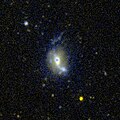NGC 1140
| Galaxy NGC 1140 |
|
|---|---|

|
|
| Photo from the Hubble Space Telescope | |
| AladinLite | |
| Constellation | Eridanus |
|
Position equinox : J2000.0 , epoch : J2000.0 |
|
| Right ascension | 02 h 54 m 33.6 s |
| declination | -10 ° 01 ′ 40 ″ |
| Appearance | |
| Morphological type | IBm / pec: / HII / Sy2 |
| Brightness (visual) | 12.5 mag |
| Brightness (B-band) | 12.8 mag |
| Angular expansion | 2.2 ′ × 1 ′ |
| Position angle | 169 ° |
| Surface brightness | 12.8 mag / arcmin² |
| Physical data | |
| Affiliation | NGC 988 group NGC 1052 group LGG 71 |
| Redshift | 0.005007 ± 0.000004 |
| Radial velocity | 1501 ± 1 km / s |
|
Stroke distance v rad / H 0 |
(66 ± 5) x 10 6 ly (20.2 ± 1.4) Mpc |
| history | |
| discovery | William Herschel |
| Discovery date | November 22, 1785 |
| Catalog names | |
| NGC 1140 • PGC 10966 • MCG -02-08-019 • IRAS 2521-1013 • 2MASX J02543354-1001426 • Mrk 1063 • VV 482 • GC 624 • H II 470 • h 275/250 • HIPASS J0254-10 • LDCE 182 NED008 | |
NGC 1140 is an active , irregular galaxy with extensive star formation regions of the Hubble type IBm in the constellation Eridanus in the southern sky . It is an estimated 66 million light years from the Milky Way and about 35,000 light years in diameter.
In the same area of the sky are u. a. the galaxies NGC 1154 and NGC 1155 .
The object was discovered on November 22, 1785 by the astronomer Wilhelm Herschel with a 48 cm telescope.
UV recording using GALEX
Web links
Commons : NGC 1140 - collection of images, videos, and audio files
- SIMBAD Astronomical Database
- astronews.com: Picture of the day July 22, 2015

